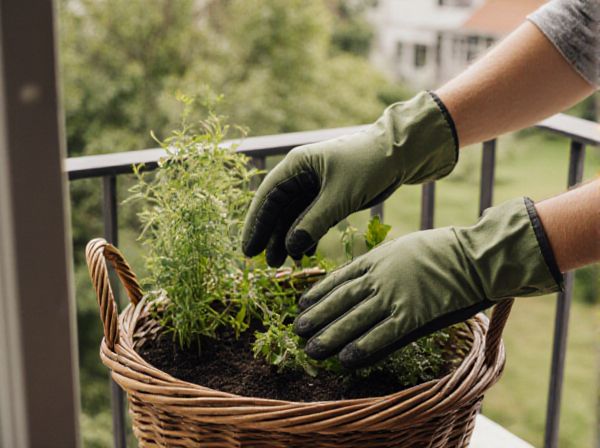
Balcony basket vs hanging container Illustration
A balcony basket offers a sturdy and decorative option ideal for railing edges, providing ample space for a variety of plants and easy access for watering. Hanging containers save space by suspending plants vertically, making them perfect for small balconies or areas with limited surface area. Both options enhance balcony aesthetics but differ in installation methods and spatial efficiency.
Table of Comparison
| Feature | Balcony Basket | Hanging Container |
|---|---|---|
| Installation | Hooks or railing mounts | Ceiling or beam hooks |
| Capacity | Medium, fits balcony rails | Varies, generally smaller volume |
| Mobility | Easy to move along railing | Stationary once hung |
| Plant Types | Flowers, herbs, small veggies | Trailing plants, orchids, ferns |
| Sunlight Exposure | Depends on balcony orientation | Flexible placement, can adjust height |
| Drainage | Usually has drainage holes | Depends on container design |
| Space Efficiency | Utilizes railing space effectively | Optimizes vertical space |
Introduction: Balcony Basket vs Hanging Container
Balcony baskets offer compact, decorative planting options that maximize limited outdoor spaces with built-in hooks or rail attachments. Hanging containers provide versatile placement choices, supporting a wider variety of plant types with suspended designs that improve air circulation and sunlight exposure. Both solutions enhance balcony gardening by efficiently utilizing vertical space and elevating aesthetic appeal.
Space Efficiency Comparison
Balcony baskets maximize vertical space by attaching directly to railings, freeing up floor area for other uses. Hanging containers utilize overhead space, allowing multiple plants to be suspended without occupying any ground footprint. Both options enhance space efficiency, but balcony baskets are ideal for narrow, linear spaces, whereas hanging containers offer more flexibility in compact or clustered arrangements.
Aesthetic Appeal and Design
Balcony baskets provide a compact, streamlined look ideal for small spaces, enhancing the railing's natural aesthetic with lush greenery or colorful blooms. Hanging containers offer more design versatility by allowing plants to cascade freely, adding dynamic layers and texture to outdoor areas. Both options elevate balcony decor, with baskets fitting minimalist themes and hanging containers supporting eclectic or bohemian styles.
Plant Selection Suitability
Balcony baskets are ideal for lightweight, trailing plants such as petunias, fuchsias, and ivy that thrive in well-drained conditions and require good air circulation. Hanging containers better accommodate a wider variety of plants, including herbs, succulents, and compact flowers like geraniums, due to their deeper root space and versatile placement options. Selecting plants based on growth habit, water needs, and weight capacity ensures optimal health and aesthetic appeal in both balcony baskets and hanging containers.
Installation and Maintenance
Balcony baskets offer easy installation with built-in hooks that securely attach to railings, requiring minimal effort and tools, while hanging containers often need more precise mounting hardware and support structures. Maintenance of balcony baskets involves frequent cleaning due to their exposure and limited drainage, whereas hanging containers may require periodic checks of hanging mechanisms along with regular watering and soil care. Both options demand attention to prevent damage from weather, but balcony baskets typically allow faster access for upkeep.
Watering and Drainage Differences
Balcony baskets typically feature built-in liners or coco coir that retain moisture longer but may require more frequent watering to prevent root rot due to limited drainage holes. Hanging containers usually have multiple drainage holes promoting faster water runoff, which demands more regular watering to keep plants hydrated. Proper selection depends on balancing moisture retention and drainage to suit plant species' water needs.
Mobility and Flexibility
Balcony baskets offer easy mobility as they can be quickly moved or adjusted along railings, providing flexible placement options for varying sunlight and space needs. Hanging containers are typically suspended from hooks or brackets, limiting their mobility but allowing for vertical gardening and efficient use of limited balcony space. Choosing between the two depends on whether frequent repositioning or maximizing vertical gardening area is the priority.
Cost Effectiveness and Budget
Balcony baskets generally offer a more cost-effective solution compared to hanging containers due to their simpler installation and lower material costs. Hanging containers often require sturdier hooks and brackets, increasing overall expenses and maintenance needs. For budget-conscious gardeners, balcony baskets provide an affordable option without compromising plant space or aesthetic appeal.
Common Challenges and Solutions
Balcony baskets and hanging containers often face common challenges such as limited weight capacity, exposure to wind, and water drainage issues. Lightweight materials and secure mounting brackets help prevent structural damage and detachment caused by strong gusts. Incorporating self-watering systems and drip trays addresses overwatering and root rot, ensuring healthier plant growth in restricted outdoor spaces.
Conclusion: Choosing the Best for Your Balcony
Balcony baskets offer a sturdy, space-saving solution perfect for small outdoor areas, while hanging containers provide versatility and decorative appeal with easy repositioning. Selecting the best option depends on your balcony size, plant types, and maintenance preferences to maximize growth and aesthetic value. Prioritize durability, drainage, and weight capacity to ensure long-term success with either choice.
Balcony basket vs hanging container Infographic

 gardendif.com
gardendif.com